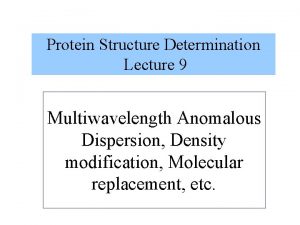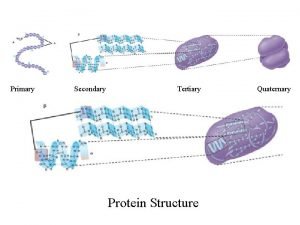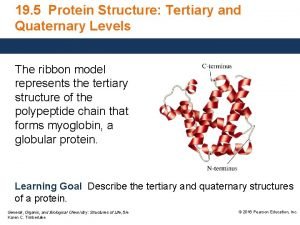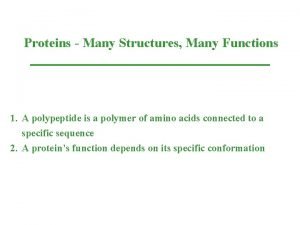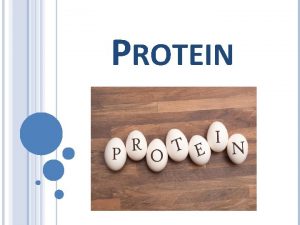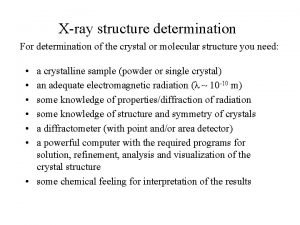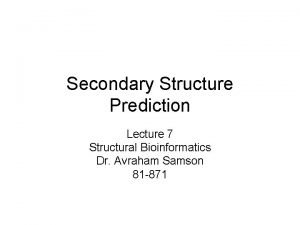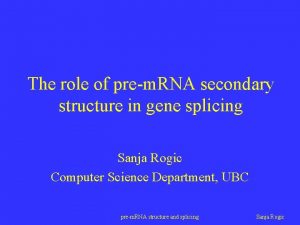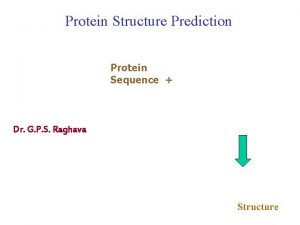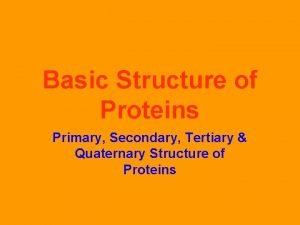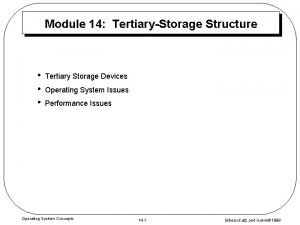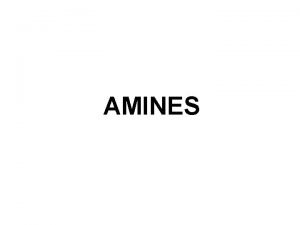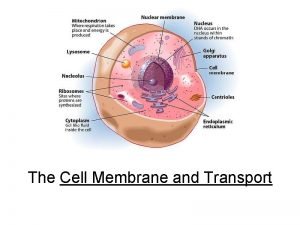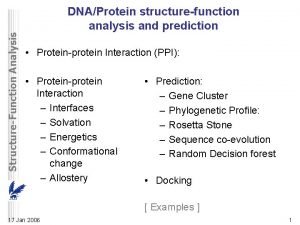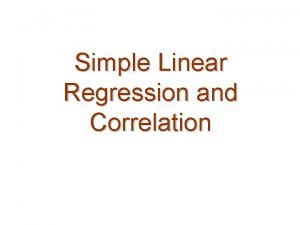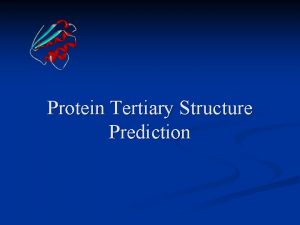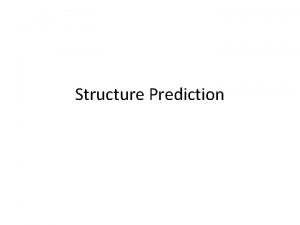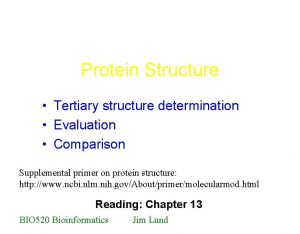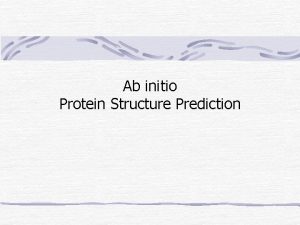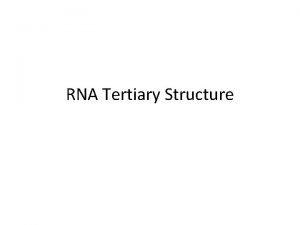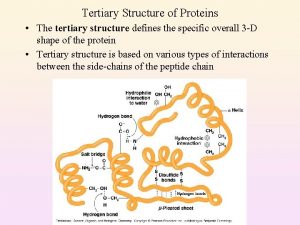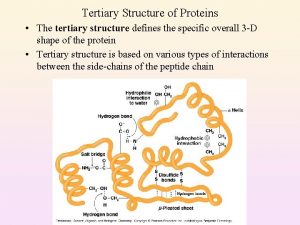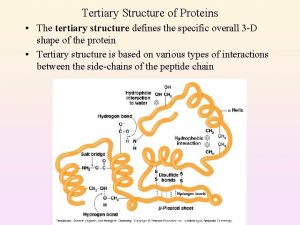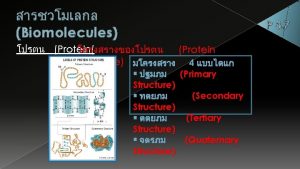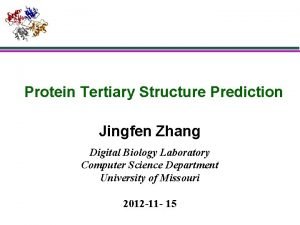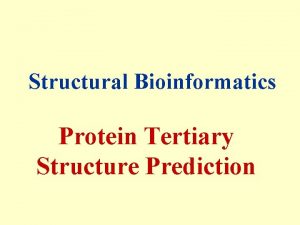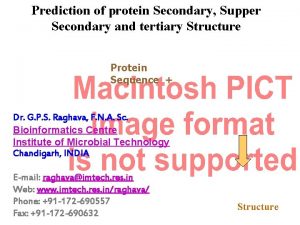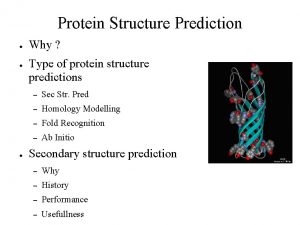Protein structure determination prediction Tertiary protein structure protein

![Tertiary protein structure: protein folding Three main approaches: [1] experimental determination (X-ray crystallography, NMR) Tertiary protein structure: protein folding Three main approaches: [1] experimental determination (X-ray crystallography, NMR)](https://slidetodoc.com/presentation_image_h/21f5504e1ed297dd2115bebc7587a079/image-2.jpg)
![Experimental approaches to protein structure [1] X-ray crystallography -- Used to determine 80% of Experimental approaches to protein structure [1] X-ray crystallography -- Used to determine 80% of](https://slidetodoc.com/presentation_image_h/21f5504e1ed297dd2115bebc7587a079/image-3.jpg)















- Slides: 18

Protein structure determination & prediction
![Tertiary protein structure protein folding Three main approaches 1 experimental determination Xray crystallography NMR Tertiary protein structure: protein folding Three main approaches: [1] experimental determination (X-ray crystallography, NMR)](https://slidetodoc.com/presentation_image_h/21f5504e1ed297dd2115bebc7587a079/image-2.jpg)
Tertiary protein structure: protein folding Three main approaches: [1] experimental determination (X-ray crystallography, NMR) [2] Comparative modeling (based on homology) [3] Ab initio (de novo) prediction (Dr. Ingo Ruczinski at JHSPH)
![Experimental approaches to protein structure 1 Xray crystallography Used to determine 80 of Experimental approaches to protein structure [1] X-ray crystallography -- Used to determine 80% of](https://slidetodoc.com/presentation_image_h/21f5504e1ed297dd2115bebc7587a079/image-3.jpg)
Experimental approaches to protein structure [1] X-ray crystallography -- Used to determine 80% of structures -- Requires high protein concentration -- Requires crystals -- Able to trace amino acid side chains -- Earliest structure solved was myoglobin [2] NMR -- Magnetic field applied to proteins in solution -- Largest structures: 350 amino acids (40 k. D) -- Does not require crystallization

Steps in obtaining a protein structure Target selection Obtain, characterize protein Determine, refine, model the structure Deposit in database

X-ray crystallography http: //en. wikipedia. org/wiki/X-ray_diffraction Sperm Whale Myoglobin



Nuclear magnetic resonance spectroscopy http: //en. wikipedia. org/wiki/Nuclear_magnetic_resonance




Article

Ab initio protein prediction n Starts with an attempt to derive secondary structure from the amino acid sequence Predicting the likelihood that a subsequence will fold into an alpha-helix, beta-sheet, or coil, using physicochemical parameters or HMMs and ANNs ¨ Able to accurately predict 3/4 of all local structures ¨

Secondary structure prediction Chou and Fasman (1974) developed an algorithm based on the frequencies of amino acids found in a helices, b-sheets, and turns. Proline: occurs at turns, but not in a helices. GOR (Garnier, Osguthorpe, Robson): related algorithm Modern algorithms: use multiple sequence alignments and achieve higher success rate (about 70 -75%) Page 279 -280



Fold recognition (structural profiles) Attempts to find the best fit of a raw polypeptide sequence onto a library of known protein folds n A prediction of the secondary structure of the unknown is made and compared with the secondary structure of each member of the library of folds n

Threading n Takes the fold recognition process a step further: ¨ Empirical-energy functions for residue pair interactions are used to mount the unknown onto the putative backbone in the best possible manner
 Protein structure determination
Protein structure determination Primary secondary tertiary quaternary structure
Primary secondary tertiary quaternary structure Primary secondary and tertiary protein structure
Primary secondary and tertiary protein structure Protein tertiary structure bonds
Protein tertiary structure bonds Leucine polar or nonpolar
Leucine polar or nonpolar Primary secondary and tertiary structure of protein
Primary secondary and tertiary structure of protein Structural protein
Structural protein Koji tsuda
Koji tsuda X-ray structure determination
X-ray structure determination Phd secondary structure prediction
Phd secondary structure prediction Rna secondary structure prediction
Rna secondary structure prediction Protein structure
Protein structure Primary secondary tertiary quaternary
Primary secondary tertiary quaternary Tertiary storage
Tertiary storage Primary, secondary tertiary amine
Primary, secondary tertiary amine Tertiary structure
Tertiary structure Protein pump vs protein channel
Protein pump vs protein channel Protein-protein docking
Protein-protein docking Coefficient of determination formula in regression
Coefficient of determination formula in regression
